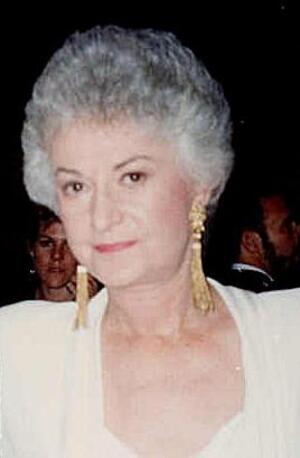Bea Arthur
Born Bernice Frankel in 1922, Bea Arthur grew up in Cambridge, Maryland, but moved to New York after college to act. She became a Broadway star in the 1960s with roles in Fiddler on the Roof and Mame, but she became an icon on television. In the 1970s, Arthur played Maude, Archie Bunker’s feminist nemesis on All in the Family and Maude, tackling taboo subjects like abortion. In the 1980s and 1990s, Arthur played divorcee Dorothy, one of four older sexually active women living together in a Florida retirement community, on The Golden Girls. Arthur’s strong female characters challenged traditional gender roles, earning her love from female and gay audiences. She repaid that love with support for the gay community before her death in 2009.
“Let’s face it,” actor Bea Arthur told an interviewer in 1985, “nobody ever asked me to play Juliet.” At five feet, nine and a half inches, with a deep voice and commanding presence, Arthur made her career playing “strong women” who spoke their own minds and controlled everyone around them. Although these women included such formidable stage characters as Yente in Fiddler on the Roof and Vera Charles in Mame, Arthur became best known for portraying two television icons. First, she played the liberal Maude Findlay, the “women’s libber” who stuck it to Archie Bunker on television’s All in the Family and then dominated her own situation comedy, Maude, throughout the 1970s. Then in the 1980s, Arthur’s portrait of the divorced English teacher Dorothy Zbornak on the beloved television show The Golden Girls helped to normalize sexuality for older women, while communicating pro-gay messages that made her a gay icon. Arthur’s characters left a lasting imprint on American television and American culture, and her political activism left a lasting imprint in the New York gay world.
Family, Education, and Early Career
Born Bernice Frankel in New York City on May 13, 1922, Arthur was the middle child of Phillip and Rebecca Frankel’s three daughters. When Arthur was eleven, her father’s financial troubles led him to move the family to Cambridge, Maryland, to run a clothing store. As one of the only Jews in a segregated southern city, as well as the tallest girl in all her school classes, Arthur faced antisemitic rejection, considered herself a “misfit,” and grew up “painfully shy.” She spent much of her time reading movie magazines and dreaming of becoming “a little, short, blonde movie star.” To hide her insecurities, Arthur developed a mean Mae West impression and won the title of “wittiest girl” in her class at Cambridge High School. After two additional years at private Linden Hall High School, Arthur studied at Blackstone College, a junior college in Virginia, and then at the Franklin Institute of Science and Arts, where she completed coursework in clinical lab technique.
After working for a year as a medical laboratory technician in Cambridge, Arthur left for New York “to become someone else.” She took a number of jobs, including serving in the Marines from 1943 through 1945. She entered the New School’s famous Dramatic Workshop to study with Edwin Piscator, along with classmates Harry Belafonte, Walter Matthau, Rod Steiger, and Tony Curtis. Although Piscator admired her height and deep voice and cast her in the leading role in classical plays like Taming of the Shrew and Clytemnestra, Arthur was unable to find professional work in classical theater and instead began her career singing in nightclubs and reading bit parts on Sid Caesar’s Show of Shows. In 1947, she changed her name legally to Bea Aurthur when she married a fellow Marine and future television writer, Robert Aurthur. The marriage, unlike the name, did not stick, and the couple divorced in 1950. That same year, however, Arthur married fellow Piscator student, actor, and director Gene Saks, and the two entered domestic bliss making audition rounds together.
Bea Arthur’s career took off when she landed the role of Lucy Brown in the long-running off-Broadway hit The Threepenny Opera in 1954. Receiving excellent reviews, Arthur was soon in demand as a character actor. Critics praised her for her “skillfully devastating” satire and claimed that she “ooze[d] comic command” in her various roles on and off Broadway. In 1964, she created the role of Yente the Matchmaker in Fiddler on the Roof on Broadway, and in 1966, she won the Tony Award for “best supporting actress” for her portrayal of the acid-tongued Vera Charles in Mame, directed by her husband.
Maude and Dorothy
Despite her successes on Broadway, however, Arthur won her genuine celebrity status when Norman Lear, the creator of All in the Family and a longtime admirer of Arthur, persuaded her to do a guest spot on the show in 1971. Appearing as Maude, Edith’s limousine-liberal cousin, Arthur skewered Carroll O’Connor’s Archie and won the immediate attention of CBS executives. Lear worked with Arthur to create a spin-off series, Maude, which premiered in 1972 and quickly moved into the top ten in the Nielsen ratings, winning Arthur an Emmy in 1977. In its six seasons, the show explored a host of controversial topics, including alcoholism and psychoanalysis, but it was Maude’s decision to have an abortion that broke television taboos, sparked loud protest, and propelled the show’s popularity in the liberal political environment of the early 1970s. As Maude, Bea Arthur inspired many female viewers as she came to symbolize the growing women’s movement, portraying a woman who “looked real . . . [who] said what she felt and could tell her husband to go to hell.”
Maude’s outspoken liberalism and controlling nature marked her as a stereotypical Jewish mother in the minds of some critics. Arthur and Saks insisted in 1972, however, that the show’s creators had intentionally made Maude a WASP matron because “if you made her Jewish . . . her courage in fighting bigotry would be personal instead of ideological.” Although this assertion reflects television writers’ (and perhaps Arthur’s) uneasiness with Jewish identity, it also yields a grain of truth. Had Maude been labeled “a Jewish mother,” her courage and fiery independence probably would have been caricatured as insignificant nagging. The decision to make Maude a WASP allowed her to be a “prototypical woman” and thus an icon of the women’s movement.
In real life, Bea Arthur’s attitude toward feminism was much more ambivalent than that of her alter ego. In the early 1970s, Arthur insisted that she did not understand the women’s movement: “I’ve never felt that being a wife and mother isn’t enough.” Interviews portrayed her as a gentle, unpretentious woman deeply tied to her husband and two sons, and nothing like the threatening Maude. By 1978, however, the series had produced tensions that shattered Arthur’s longtime marriage to Gene Saks, and in later interviews, Arthur actually adopted the language of the women’s movement: “I don’t think I ever truly believed in marriage anyway,” she told an interviewer in 1985. “I guess marriage means that you’re a woman and not a . . . person.”
Befitting her new status as a single, older woman, Bea Arthur created a new television character in the 1980s: Dorothy Zbornak, the divorced schoolteacher of The Golden Girls. From 1985 to 1992, Arthur played Dorothy as the sharp-tongued leader of four older women who lived together in Florida, coping with aging while looking for love and enjoying female friendship. This realistic, funny portrayal of sexually active senior citizens won the series a loyal older audience, as well as a substantial gay audience. The show helped Arthur garner a second Emmy in 1988. She also won an American Comedy Award (2001) and an Emmy nomination (2000) for guest appearances on the TV series Malcolm in the Middle. Arthur then returned to the world of Broadway— both on stage, performing solo in her own “Bea Arthur on Broadway: Just Between Friends,” and in a documentary, “Broadway: The Golden Age, by the Legends Who Were There.”
Legacy
Throughout her television stardom, Arthur had close friendships and connections with gay men in Hollywood. Her son remembered parties at their house with celebrities like Rock Hudson. Those connections with gay men—and The Golden Girls’ status as a queer-friendly show—led her to political activism. In 2005, Arthur heard from a friend that the Ali Forney Center, an organization for homeless LGBT youth in New York City, was facing financial hardship. Arthur flew from Los Angeles to New York to mount a benefit performance of “Bea Arthur on Broadway,” raising $40,000 for the center and helping to get it through the recession of the 2000s. Arthur left $300,000 to the center in her will, which opened an eighteen-bed shelter, the Bea Arthur Residence for LGBT Youth, in 2017.
Despite her continued identification with the theater in the 2000s, it was clearly television audiences that most warmly embraced Bea Arthur’s “strong women,” and it was through television that Arthur most influenced American culture. On Maude, Arthur helped break down television barriers and normalize topics like abortion and alcoholism as subjects for open discussion; on Golden Girls, the characters openly addressed female sexuality, transgender identity, and HIV/AIDS. Perhaps even more importantly, Arthur’s distinctive portrayals of Maude and Dorothy challenged and reshaped Americans’ conceptions of women and gender. The sharp-tongued hero who does not conform to cultural standards of youthful beauty or wifely duty but who holds herself tall and speaks her mind has been a rarity in American popular culture. Bea Arthur embodied this rarity and helped to usher in a new culture more open to challenging gender stereotypes and embracing divergent sexual identities.
Arthur passed away on April 25, 2009, at the age of 86.
Abramovitch, Seth. “How Bea Arthur Gave Back to the Gays Who Loved Her.” Hollywood Reporter (September 23, 2016), https://www.hollywoodreporter.com/tv/tv-news/bea-arthur-lgbt-teen-homel….
“Bea Arthur: American Marine.” The National WWII Museum (April 12, 2018), https://www.nationalww2museum.org/war/articles/bea-arthur-us-marine.
Breslauer, Jan. “Arthur, Arthur.” Los Angeles Times, October 8, 1995.
Current Biography (December 1973).
Flatley, Guy. “Gene, for Heaven’s Sake Help Me!!” TV Guide (November 18, 1972).
Harmetz, Aljean. “Maude Didn’t Leave ‘Em All Laughing.” NYTimes, December 10, 1972.
Harmetz, Aljean. “NBC’s Golden Girls Gambles on Grown-Ups.” NYTimes, September 22, 1985.
Hentoff, Nat. “New Candor in Old America.” Village Voice, September 28, 1972.
Hodenfield, Jan. “Maude Meets Mame.” New York Post, March 9, 1974.
Honeycutt, Kirk. “We Ran Out of Controversy.” NYTimes, April 16, 1978.
“Maude Fraud.” People (November 17, 1975): 35–38.
Oppenheimer, Dabby. “Maude Minces No Words.” Lady’s Circle (November 1974): 22+.
Ratliff, Shannon. “Golden Girl Bea Arthur Was One of the First Female Marines Ever, Because She’s Always Been a Boss.” Rare, February 6, 2021, https://rare.us/people/bea-arthur-marine-bernice-frankel/.
Renold, Evelyn. “Bea Arthur.” New York Daily News, October 13, 1985.
Stone, Judy. “She Gave Archie His First Comeuppance.” NYTimes, November 19, 1972.
“Beatrice Arthur.” TV Tome, 2004.




